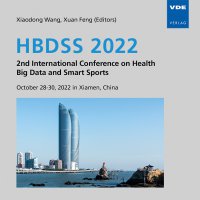Research on Gait Angle Variables to Personal Best Performance Based on Machine Learning Regression Model
Konferenz: HBDSS 2022 - 2nd International Conference on Health Big Data and Smart Sports
28.10.2022-30.10.2022 in Xiamen, China
Tagungsband: HBDSS 2022
Seiten: 5Sprache: EnglischTyp: PDF
Autoren:
Kong, Liwen (Institute of Medical Engineering and Translational Medicine, Tianjin University, Tianjin, China & College of Information Engineering, Dalian University, Dalian, China)
Chen, Yiyuan; Tao, Shuai (College of Information Engineering, Dalian University, Dalian, China)
Ye, Dongmei (Department of Rehabilitation, Zhongshan Hospital, Dalian University, Dalian, China)
Wang, Liheng (Department of Rehabilitation, The Second People's Hospital of Dalian Dalian, China)
Inhalt:
Marathons are becoming more and more popular among sports enthusiasts. In order to separately evaluate the effect of gait angle variables on the personal best performance of marathon runners, 28 marathon runners with excellent Harris score were recruited in this study. Gait angle variables were collected through the gait detection system worn by athletes, and single task and dual task experiments were completed. The collected hip joint angle and knee joint angle when the heel strike the ground, hip joint angle and knee joint angle when the toe off the ground, heel strike the ground angle and Heel strike angle were used as independent variables, and the personal best performance obtained during running was used as dependent variable to construct a multiple linear regression analysis model. The regression model was used for machine learning training of gait parameter samples, the least square method was used to calculate the loss function, and the ten-fold cross validation was used to verify the fitting model. The results showed that the hip joint angle (toe off) had a significant positive effect on the best performance in the single task experiment (t=2.316, P=0.031<0.05). In the dualtask experiment, the knee joint angle measured when toe off had a significant negative effect on the best performance (t=-2.082, P=0.050<0.05). The toe off angle had a significant negative effect on the best performance (t=-2.127, P=0.045<0.05). The R square value of the regression model constructed under the dual task was higher than that under the single task (0.509>0.436). Gait parameters under dual tasks can better predict the best performance of athletes.


